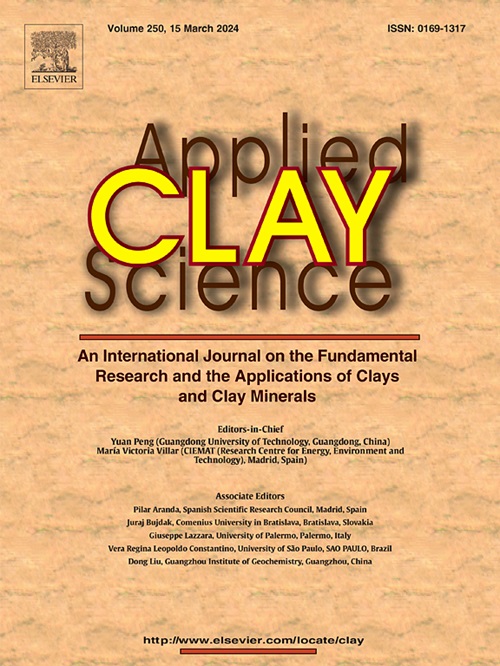Bentonite mass loss in fractured crystalline rock quantified from CT scans using digital rock physics and machine learning: case study from the Grimsel Test Site (Switzerland)
IF 5.8
2区 地球科学
Q2 CHEMISTRY, PHYSICAL
引用次数: 0
Abstract
Bentonite plays a critical role in engineered barrier systems designed for radioactive waste storage in geological repositories especially in crystalline formations. Ensuring its long-term stability under realistic hydrogeochemical conditions is vital for evaluating the safety of these repositories. This study investigated the influence of controlled water flow in a shear zone on the erosion of bentonite through a 4.5-year Long-Term In-Situ Test (LIT) at the Grimsel Test Site, Switzerland. Compacted Ca-Mg-type FEBEX bentonite rings (with 90 % montmorillonite content) were positioned in-situ in an emplacement borehole intersecting a water-conducting shear zone providing direct contact with low-mineralized glacial meltwater. X-ray computed tomography scanning, along with digital rock physics methods, were used to quantify bentonite mass loss and the contact shear zone aperture distribution on over-cored LIT samples. A Random Forest classifier, a machine learning technique, was used for segmentation, which enabled more precise quantification of bentonite mass loss and improved fault characterization. This approach used multiphase segmentation, allowing accurate distinction between different material phases in the cored interval, which is essential for resolving complex interactions in heterogeneous systems. The selection of the correct region of interest was crucial for minimizing segmentation errors and improving mass loss quantification by reducing interferences from non-relevant structures. The aperture distribution between the three boreholes over-cored within the shear zone was evaluated with a mean thickness of 2.90 ± 1.09 mm (2σ). Furthermore, the bentonite mass loss was computed from the scanned images and compared with mobilised montmorillonite colloid masses, continuously sampled in the water from observation boreholes (0.11–0.12 m and 6 m distance) measured by inductively coupled plasma mass spectrometry (ICP-MS) and laser-induced breakdown detection (LIBD) techniques. The data evaluation of both techniques used in this study provided erosion rates <2 kg/m2/y, which are at least two orders of magnitude below the mass loss assessment rates of 500 to 1500 kg/m2/y defined by safety case considerations of the Swedish Nuclear Fuel and Waste Management Company (Svensk Kärnbränslehantering Aktiebolag, SKB) and the Finnish company POSIVA handling the final disposal of the spent nuclear fuel generated by its owners, the nuclear plant operators Teollisuuden Voima and Fortum. The creation of a digital twin model for the bentonite-water-shear zone system provided new insights into the erosion processes showing inhomogeneous erosion in contact with real fracture geometries.
利用数字岩石物理和机器学习技术,通过CT扫描量化破碎结晶岩中膨润土的质量损失:来自瑞士Grimsel试验场的案例研究
膨润土在设计用于放射性废物储存的工程屏障系统中起着至关重要的作用,特别是在结晶地层中。确保其在现实水文地球化学条件下的长期稳定性对于评价这些储库的安全性至关重要。本研究在瑞士Grimsel试验场进行了为期4.5年的长期原位试验(LIT),研究了剪切带中控制水流对膨润土侵蚀的影响。压实的ca - mg型FEBEX膨润土环(含90%蒙脱土)被原位定位在与导水剪切带相交的定位钻孔中,该剪切带与低矿化的冰川融水直接接触。x射线计算机断层扫描,以及数字岩石物理方法,用于量化膨润土质量损失和接触剪切带孔径分布在过芯LIT样品上。使用随机森林分类器(一种机器学习技术)进行分割,从而可以更精确地量化膨润土质量损失并改进故障表征。该方法使用多相分割,允许在芯层中准确区分不同的材料相,这对于解决异质系统中的复杂相互作用至关重要。选择正确的感兴趣区域对于最小化分割错误和通过减少非相关结构的干扰来改进质量损失量化至关重要。剪切带内三个孔间的孔径分布,平均厚度为2.90±1.09 mm (2σ)。此外,通过扫描图像计算了膨润土的质量损失,并将其与从观测井(0.11-0.12 m和6 m距离)中连续取样的蒙脱土胶体质量进行了比较,这些观测井通过电感耦合等离子体质谱(ICP-MS)和激光诱导击穿检测(LIBD)技术进行了测量。本研究中使用的两种技术的数据评估提供了2 kg/m2/y的侵蚀率,这至少比瑞典核燃料和废物管理公司(Svensk Kärnbränslehantering Aktiebolag, SKB)和处理其所有者产生的乏核燃料的最终处置的芬兰公司POSIVA的安全案例考虑所定义的500至1500 kg/m2/y的质量损失评估率低两个数量级。核电站运营商Teollisuuden Voima和Fortum。为膨润土-水-剪切带系统创建的数字孪生模型为侵蚀过程提供了新的见解,显示了与真实裂缝几何形状接触的非均匀侵蚀。
本文章由计算机程序翻译,如有差异,请以英文原文为准。
求助全文
约1分钟内获得全文
求助全文
来源期刊

Applied Clay Science
地学-矿物学
CiteScore
10.30
自引率
10.70%
发文量
289
审稿时长
39 days
期刊介绍:
Applied Clay Science aims to be an international journal attracting high quality scientific papers on clays and clay minerals, including research papers, reviews, and technical notes. The journal covers typical subjects of Fundamental and Applied Clay Science such as:
• Synthesis and purification
• Structural, crystallographic and mineralogical properties of clays and clay minerals
• Thermal properties of clays and clay minerals
• Physico-chemical properties including i) surface and interface properties; ii) thermodynamic properties; iii) mechanical properties
• Interaction with water, with polar and apolar molecules
• Colloidal properties and rheology
• Adsorption, Intercalation, Ionic exchange
• Genesis and deposits of clay minerals
• Geology and geochemistry of clays
• Modification of clays and clay minerals properties by thermal and physical treatments
• Modification by chemical treatments with organic and inorganic molecules(organoclays, pillared clays)
• Modification by biological microorganisms. etc...
 求助内容:
求助内容: 应助结果提醒方式:
应助结果提醒方式:


